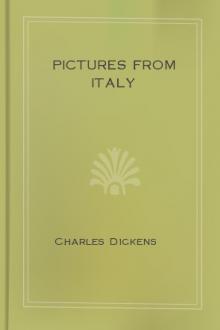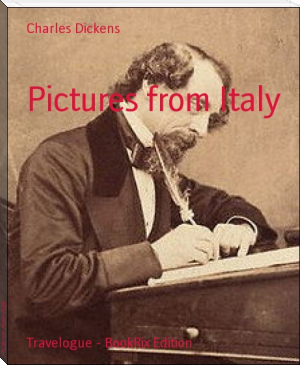Travels Through France And Italy, Tobias Smollett [love novels in english .TXT] 📗

- Author: Tobias Smollett
Book online «Travels Through France And Italy, Tobias Smollett [love novels in english .TXT] 📗». Author Tobias Smollett
And Statues, Which Are Placed In The Upper Apartments Of This
Edifice. I Saw Them But Once, And Then I Was Struck With The
Following Particulars. A Bacchanalian Drunk; A Jupiter And Leda,
At Least Equal To That In The Gallery At Florence; An Old
Praesica, Or Hired Mourner, Very Much Resembling Those Wrinkled
Hags Still Employed In Ireland, And In The Highlands Of Scotland,
To Sing The Coronach At Funerals, In Praise Of The Deceased; The
Famous Antinous, An Elegant Figure, Which Pousin Studied As Canon
Or Rule Of Symmetry; The Two Fauns; And Above All The Mirmillone,
Or Dying Gladiator; The Attitude Of The Body, The Expression Of
The Countenance, The Elegance Of The Limbs, And The Swelling Of
The Muscles, In This Statue, Are Universally Admired; But The
Execution Of The Back Is Incredibly Delicate. The Course Of The
Muscles Called Longissimi Dorsi, Are So Naturally Marked And
Tenderly Executed, That The Marble Actually Emulates The Softness
Of The Flesh; And You May Count All The Spines Of The Vertebrae,
Raising Up The Skin As In The Living Body; Yet This Statue, With
All Its Merit, Seems Inferior To The Celebrated Dying Gladiator
Of Ctesilas, As Described By Pliny, Who Says The Expression Of It
Was Such, As Appears Altogether Incredible. In The Court, On The
Opposite Side Of The Capitol, There Is An Admirable Statue Of A
Lion Devouring An Horse, Which Was Found By The Gate Of Ostia,
Near The Pyramid Of Caius Cestius; And Here On The Left Hand,
Under A Colonade, Is What They Call The Columna Rostrata, Erected
In Honour Of Caius Duilius, Who First Triumphed Over The
Carthaginians By Sea. But This Is A Modern Pillar, With The Old
Part 7 Letter 32 ( Nice, March 10, 1765.) Pg 271Inscription, Which Is So Defaced As Not To Be Legible. Among The
Pictures In The Gallery And Saloon Above, What Pleased Me Most
Was The Bacchus And Ariadne Of Guido Rheni; And The Wolf Suckling
Romulus And Remus, By Rubens. The Court Of The Palazzo Farnese Is
Surrounded With Antique Statues, Among Which The Most Celebrated
Are, The Flora, With A Most Delicate Drapery; The Gladiator, With
A Dead Boy Over His Shoulder; The Hercules, With The Spoils Of
The Nemean Lion, But That Which The Connoisseurs Justly Esteem
Above All The Rest Is Hercules, By Glycon, Which You Know As Well
As I Do, By The Great Reputation It Has Acquired. This Admirable
Statue Having Been Found Without The Legs, These Were Supplied By
Gulielmo De La Porta So Happily, That When Afterwards The
Original Limbs Were Discovered, Michael Angelo Preferred Those Of
The Modern Artist, Both In Grace And Proportion; And They Have
Been Retained Accordingly. In A Little House, Or Shed, Behind The
Court, Is Preserved The Wonderful Group Of Dirce, Commonly Called
The Toro Farnese, Which Was Brought Hither From The Thermae
Caracallae. There Is Such Spirit, Ferocity, And Indignant
Resistance Expressed In The Bull, To Whose Horns Dirce Is Tied By
The Hair, That I Have Never Seen Anything Like It, Either Upon
Canvass, Or In Stone. The Statues Of The Two Brothers
Endeavouring To Throw Him Into The Sea Are Beautiful Figures,
Finely Contrasted; And The Rope, Which One Of Them Holds In A
Sort Of Loose Coil, Is So Surprisingly Chizzelled, That One Can
Hardly Believe It Is Of Stone. As For Dirce Herself, She Seems To
Be But A Subaltern Character; There Is A Dog Upon His Hind Legs
Barking At The Bull, Which Is Much Admired. This Amazing Groupe
Was Cut Out Of One Stone, By Appollonius And Tauriscus, Two
Sculptors Of Rhodes; And Is Mentioned By Pliny In The Thirty-
Sixth Book Of His Natural History. All The Precious Monuments Of
Art, Which Have Come Down To Us From Antiquity, Are The
Productions Of Greek Artists. The Romans Had Taste Enough To
Admire The Arts Of Greece, As Plainly Appears By The Great
Collections They Made Of Their Statues And Pictures, As Well As
By Adopting Their Architecture And Musick: But I Do Not Remember
To Have Read Of Any Roman Who Made A Great Figure Either As A
Painter Or A Statuary. It Is Not Enough To Say Those Professions
Were Not Honourable In Rome, Because Painting, Sculpture, And
Musick, Even Rhetoric, Physic, And Philosophy Were Practised And
Taught By Slaves. The Arts Were Always Honoured And Revered At
Rome, Even When The Professors Of Them Happened To Be Slaves By
The Accidents And Iniquity Of Fortune. The Business Of Painting
And Statuary Was So Profitable, That In A Free Republic, Like
That Of Rome, They Must Have Been Greedily Embraced By A Great
Number Of Individuals: But, In All Probability, The Roman Soil
Produced No Extraordinary Genius For Those Arts. Like The English
Of This Day, They Made A Figure In Poetry, History, And Ethics;
But The Excellence Of Painting, Sculpture, Architecture, And
Music, They Never Could Attain. In The Palazzo Picchini I Saw
Three Beautiful Figures, The Celebrated Statues Of Meleager, The
Boar, And Dog; Together With A Wolf, Of Excellent Workmanship.
The Celebrated Statue Of Moses, By Michael Angelo, In The Church
Of St. Peter In Vincula, I Beheld With Pleasure; As Well As That
Of Christ, By The Same Hand, In The Church Of S. Maria Sopra
Part 7 Letter 32 ( Nice, March 10, 1765.) Pg 272Minerva. The Right Foot, Covered With Bronze, Gilt, Is Much
Kissed By The Devotees. I Suppose It Is Looked Upon As A Specific
For The Toothache; For, I Saw A Cavalier, In Years, And An Old
Woman Successively Rub Their Gums Upon It, With The Appearance Of
The Most Painful Perseverance.
You Need Not Doubt But That I Went To The Church Of St. Peter In
Montorio, To View The Celebrated Transfiguration, By Raphael,
Which, If It Was Mine, I Would Cut In Two Parts. The Three
Figures In The Air Attract The Eye So Strongly, That Little Or No
Attention Is Payed To Those Below On The Mountain. I Apprehend
That The Nature Of The Subject Does Not Admit Of That Keeping And
Dependence, Which Ought To Be Maintained In The Disposition Of
The Lights And Shadows In A Picture. The Groupes Seem To Be
Intirely Independent Of Each Other. The Extraordinary Merit Of
This Piece, I Imagine, Consists, Not Only In The Expression Of
Divinity On The Face Of Christ; But Also In The Surprising
Lightness Of The Figure, That Hovers Like A Beautiful Exhalation
In The Air. In The Church Of St. Luke, I Was Not At All Struck By
The Picture Of That Saint, Drawing The Portrait Of The Virgin
Mary, Although It Is Admired As One Of The Best Pieces Of
Raphael. Indeed It Made So Little Impression Upon Me, That I Do
Not Even Remember The Disposition Of The Figures. The Altar-Piece,
By Andrea Sacchi, In The Church Of St. Romauldus, Would
Have More Merit, If The Figure Of The Saint Himself Had More
Consequence, And Was Represented In A Stronger Light. In The
Palazzo Borghese, I Chiefly Admired The Following Pieces: A Venus
With Two Nymphs; And Another With Cupid, Both By Titian: An
Excellent Roman Piety, By Leonardo Da Vinci; And The Celebrated
Muse, By Dominechino, Which Is A Fine, Jolly, Buxom Figure. At
The Palace Of Colorina Connestabile, I Was Charmed With The
Herodias, By Guido Rheni; A Young Christ; And A Madonna, By
Raphael; And Four Landscapes, Two By Claude Lorraine, And The
Other Two, By Salvator Rosa. In The Palazetto, Or Summerhouse
Belonging To The Palazzo Rospigliosi, I Had The Satisfaction Of
Contemplating The Aurora Of Guido, The Colours Of Which Still
Remain In High Perfection, Notwithstanding The Common Report That
The Piece Is Spoiled By The Dampness Of The Apartment. The Print
Of This Picture, By Freij, With All Its Merit, Conveys But An
Imperfect Idea Of The Beauty Of The Original. In The Palazzo
Barberini, There Is A Great Collection Of Marbles And Pictures:
Among The First, I Was Attracted By A Beautiful Statue Of Venus;
A Sleeping Faun, Of Curious Workmanship; A Charming Bacchus,
Lying On An Antient Sculpture, And The Famous Narcissus. Of The
Pictures, What Gave Me Most Pleasure Was The Magdalen Of Guido,
Infinitely Superior To That By Le Brun In The Church Of The
Carmelites At Paris; The Virgin, By Titian; A Madonna, By
Raphael, But Not Comparable To That Which Is In The Palazzo De
Pitti, At Florence; And The Death Of Germanicus, By Poussin,
Which I Take To Be One Of The Best Pieces In This Great
Collection. In The Palazzo Falconeri There Is A Beautiful St.
Cecilia, By Guercino; A Holy Family, By Raphael; And A Fine
Part 7 Letter 32 ( Nice, March 10, 1765.) Pg 273Expressive Figure Of St. Peter Weeping, By Dominechino. In The
Palazzo Altieri, I Admired A Picture, By Carlo Maratti,
Representing A Saint Calling Down Lightning From Heaven To
Destroy Blasphemers. It Was The Figure Of The Saint I Admired,
Merely As A Portrait. The Execution Of The Other Parts Was Tame
Enough: Perhaps They Were Purposely Kept Down, In Order To
Preserve The Importance Of The Principal Figure. I Imagine
Salvator Rosa Would Have Made A Different Disposition On The Same
Subject: That Amidst The Darkness Of A Tempest, He Would Have
Illuminated The Blasphemer With The Flash Of Lightning By Which
He Was Destroyed: This Would Have Thrown A Dismal Gleam Upon His
Countenance, Distorted By The Horror Of His Situation As Well As
By The Effects Of The Fire; And Rendered The Whole Scene
Dreadfully Picturesque. In The Same Palace, I Saw The Famous Holy
Family, By Corregio, Which He Left Unfinished, And No Other
Artist Would Undertake To Supply; For What Reason I Know Not.
Here Too Is A Judgment Of Paris, By Titian, Which Is Reckoned A
Very Valuable Piece. In The Palazzo Odescalchi, There Is A Holy
Family, By Buonaroti, And Another By Raphael, Both Counted
Excellent, Though In Very Different Stiles, Extremely
Characteristic Of Those Two Great Rival Artists.
If I Was Silly Enough To Make A Parade, I Might Mention Some
Hundreds More Of Marbles And Pictures, Which I Really Saw At
Rome; And Even Eke Out That Number With A Huge List Of Those I
Did Not See: But Whatever Vanity I May Have, It Has Not Taken
This Turn; And I Assure You, Upon My Word And Honour, I Have
Described Nothing But What Actually Fell Under My Own
Observation. As For My Critical Remarks, I Am Afraid You Will
Think Them Too Superficial And Capricious To Belong To Any Other
Person





Comments (0)